More Las Vegas Memories
YouTube is a treasure trove of Classic Las Vegas home movie footage. Take a walk down memory lane with some of these great YouTube videos:
From Ray Lindstrom, 1956 Las Vegas Strip
From Elmer Gerlock, 1957 Las Vegas Strip and Fremont Street. Love the shot of the Golden Nugget neon billboard.
From yooreds, Las Vegas Strip circa 1976
More Las Vegas Neon
Here's a piece from Youtube. A look at the signs in the Neon Boneyard.
City of Las Vegas relights some favorite neon signs
The City of Las Vegas, working with the Neon Museum, has installed three neon signs from the Neon Boneyard. Better yet, on Monday evening, the City held a relighting ceremony as the Bow and Arrow Motel, the Horseshoe "H" and the beloved Silver Slipper were turned back on.
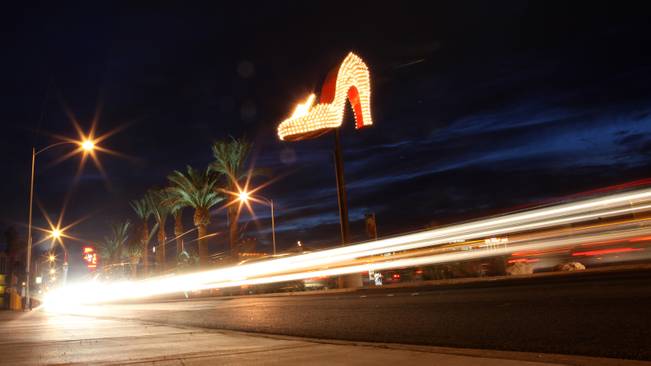
From the Las Vegas Sun:
At first glance, drivers might wonder if there's a giant ladies' footwear sale going on near Cashman Stadium.
But no. That giant sparkling high-heeled shoe perched near the tops of the palm trees along Las Vegas Boulevard North is actually a step back into the city's neon past.
Shimmering with some 980 twinkling lights, the shoe was originally the whimsical icon of the Silver Slipper Gambling Hall that had its heyday nearly a half century ago.
But now the restored 12-by-17-foot three-dimensional shoe is a symbol of the city's commitment to step up to honor its colorful historical main drag.
The Silver Slipper, which also glitters with stories about billionaire recluse Howard Hughes and even "Mr. Las Vegas" Wayne Newton, was one of three historic neon signs turned on at dusk Monday along Las Vegas Boulevard.
With a countdown led by Mayor Oscar Goodman, the three signs were lighted during a ceremony at the Reed Whipple Cultural Center.
"It was 90 years ago, in 1929, that we had the first neon here in Las Vegas turned on," Goodman said. "... We have a unique city, with a unique art form. We preserved it and we're going to continue to preserve it."
The three signs, on loan from the Neon Museum, were lit to celebrate the designation of Las Vegas Boulevard as a National Scenic Byway from Washington Avenue to the north to Sahara Avenue to the south.
"Specifically, in an economy where things are going down, ladies and gentlemen, we continue to bring lights up in the entertainment capital of the world," said Ward 5 Councilman Ricki Barlow.
The designation, granted in October, will help the city to get federal funds to restore as many as 20 historic neon signs in the median in that corridor, Goodman said.
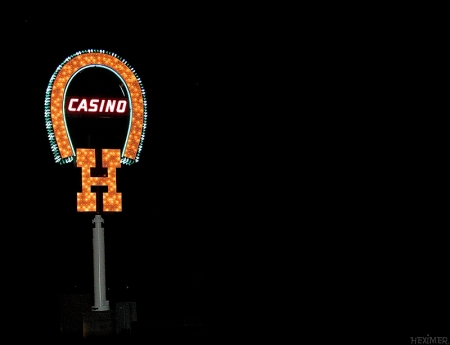
"The city council has made a decision that we're not going to implode our history. We're going to preserve our history," Goodman said.
"That's why we have the Neon Museum across the street, the Neon Boneyard. And now we're beginning to exhibit these things that make us really distinct from any other city. It's a lot of fun, number one. And number two, it has great significance because this is what we're all about. This is where we came from."
He said the city will use Las Vegas Boulevard's new scenic byway as a canvas for painting the city's history with its local art form, neon signs.
"This is our history," he said. "We're unique here in Las Vegas. ... No other place has the kind of art form that we have. I think it's very important when people go up and down this particular road that they're able to share our history with us and enjoy these very iconic locations."
Among dignitaries attending the ceremony was U.S. Rep. Shelley Berkley, D-Nev., who remembered one of the first things she saw upon coming to Las Vegas as a child were the glittering signs.
"I remember through 12-year-old eyes, driving down the Strip for the first time and seeing this extraordinary street with this magnificent neon," she said. "I remember thinking when I was 12 years old this is the most remarkable street I have ever seen. Forty-seven years later I drive down the same street, I have the same reaction and it takes my breath away."
A cultural corridor
City Manager Betsy Fretwell said the highest concentration of cultural institutions in Las Vegas was in the vicinity of the signs, including Cashman Center, the Las Vegas Library, the Natural History Museum, the Lied Discovery Children's Museum, the Neon Museum, the Old Las Vegas Mormon Fort, the State Historic Park and the Reed Whipple Cultural Center.
The first three vintage signed were refurbished and installed in new landscaped median islands for $1.1 million.
About a block to the south of the glittering slipper is the original sign for the Bow & Arrow Motel. At 35-feet tall and six-feet wide, it lights up the median near Bonanza Street with bright red lettering and an animated arrow being strung onto a bow.
The sign was the beacon for the motel that originally located in the downtown on Las Vegas Boulevard at Wyoming Avenue during the late 1950s or early 60s.
To the north, in the median that splits the street into a byway, is another sign that once glittered at Binion's Horseshoe Casino on Fremont Street. The sign was built by Young Electric Sign Company and installed in the 1960s.
The 13-by-12-foot rotating sign features a large golden neon horseshoe trimmed in blue neon lights, with an "H" at the bottom in gold flashing neon and red "CASINO" in the center.
"That's as important as any sign in the community," Goodman said. "When Benny Binion opened the Horseshoe, we established our reputation as being able to take a bet on anything and no limit. And that's what Las Vegas is all about.
Tales of the Silver Slipper
Before the ceremony, William Marion, who chairs the Neon Museum Board, told a story about Howard Hughes' and Wayne Newton's involvement with the Silver Slipper sign.
Hughes, who had moved to the Desert Inn in late 1968 and eventually bought it, had a penthouse directly across the street from the Silver Slipper sign, which was brightly lit and rotated. Hughes made a request that it be turned off.
"They wouldn't shut it off, so he told his aides to buy the property," Marion said. "That's how he got to own the Silver Slipper."
There were other rumors, too, about why Hughes bought the Silver Slipper, including he thought someone had put a camera in its toe that was pointed at his penthouse and spying on him.
Wayne Newton's involvement with the Silver Slipper sign came after Hughes had the sign taken down.
Newton had come to the sign's resting place, in the city's Neon Boneyard, to do promotional shoot years later. And when the 6-foot-3, barrel-chested singer stepped up on its toe, his foot went through it, Marion said.
Colorful characters
Goodman said he used to spend a lot of time over at the Silver Slipper, which he called "one of the original joints, so to speak."
"It had a lot of colorful people who used to hang out there at that part of the Strip," he said.
Goodman, known for his love of martinis, chuckled at the thought of how much of his favorite gin that particular Silver Slipper sign might hold. No, the mayor said. He hadn't done the math.
"Now that you mention it, it takes on a very special significance," he said, chuckling.
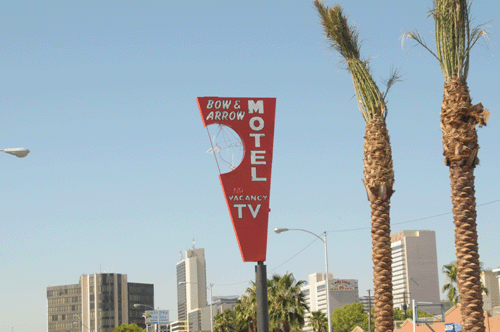
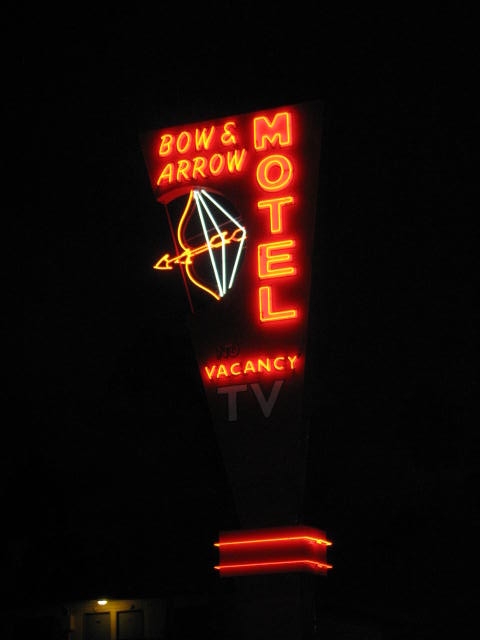
Thanks also to Jack LeVine at VeryVintageVegas.com for allowing us to use some of these images
Florence McClure, activist, has died
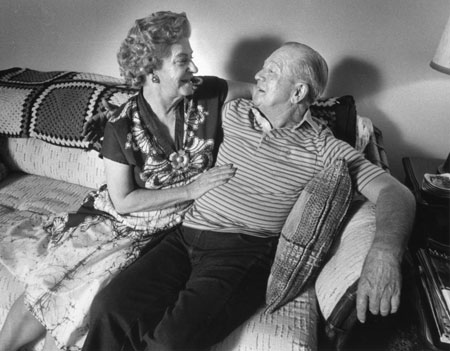
"Hurricane Flo" and her husband, Jim
To many living in Las Vegas, they only know her as a name on a building but for many of us of a certain age, she was one of the pioneering women of post-war Las Vegas. In a year that has seen too many of our post-war pioneers passing away, this one makes the year even sadder.
From the R-J:
Florence McClure, nicknamed “Hurricane Flo” by the politicians she hounded and the journalists who covered her, was not the type of mother who stayed home and baked cookies, daughter Carolyn McClure Dunne recalled today. She was a working woman before there were working women, she said.
McClure, a renowned advocate for women’s rights in Nevada and for whom the women’s correctional facility in North Las Vegas is named, died Thursday. She was 88. Dunne said her mother, famous for pestering legislators until they listened, earned every word in her nickname. “She was a whirlwind,” Dunne said. “She would come in and bowl over a room, bring everyone together, speak her point, and no one would say no.” University of Nevada, Las Vegas history professor Joanne Goodwin said McClure was a formidable advocate who had her hand in nearly every women’s group in town. McClure started what would become the Rape Crisis Center out of her home in 1974, and in 1975, she began petitioning the state Legislature on outdated rape laws, Goodwin said. In that first year, McClure’s petitions were directly responsible for a bill that made it illegal to admit the sexual history of a rape victim as evidence in court, unless it was directly related to the case. Today that might seem typical, Goodwin said, but in the early 1970s, marital rape wasn’t even considered a crime. “She overcame some big hurdles. That was also the year that rape changed from sexual battery to sexual assault, a major shift in the seriousness of the crime,” Goodwin said. Marlene Adrian, president of Women of Diversity Productions, produced the documentary “Hurricane Florence” about McClure’s life. She said McClure would often sit with rape victims in court, and sometimes was the only person there for the victim. “She was trying to make sure they’d feel they had at least one support person in the audience,” Adrian said. McClure carried her work into the ’80s and ’90s, continuing to focus on the rights of women — even those in prison. Dunne said her mother believed the women’s correctional facility should be moved closer to the city. A rural location might have been out of the public eye, but it was also farther away from the families of the prisoners, she said. “She wanted it close enough for the kids to see their parents, so in turn the women would have incentive to rehabilitate,” Dunne said. The women’s prison was moved to North Las Vegas in 1997 and named after McClure in 2007. Dunne said McClure was always busy during Dunne’s childhood, and it wasn’t until Dunne was an adult that they forged a stronger relationship. By then, the “osmosis process” had begun, and Dunne found herself participating in events with her mother. “We’re not all meant to be exactly the same, but I got some very good things from her,” she said. One of the little-known facts about McClure, Dunne said, was that she didn’t want every person who committed crimes against women to rot in jail forever, as was the perception. When a male teenager’s family approached McClure about helping their son, who was being released from prison after committing a sex crime, McClure was more than happy to help, Dunne said. “She helped him get integrated back into the work force and championed him to get his life turned around,” she said. “That’s what she was about, what she wanted people to do — make a better life for people.”
Popular Las Vegas attorney, James "Bucky" Buchanan unexpectedly dies
Popular Las Vegas attorney and reality television star, James "Bucky" Buchanan unexpectedly died last night after suffering a "medical episode" while trying to back his Ferrari into his drive-way.
From the R-J:
Well-known Las Vegas attorney James “Bucky” Buchanan died in a traffic accident Saturday night after he crashed a Ferrari into a wall, Las Vegas police said. The accident occurred just before 6 p.m. at Linden Avenue and Wilshire Boulevard, near Bonanza Road and Hollywood Boulevard, Las Vegas police Lt. Steve Herpolsheimer said. He said Buchanan was the only person in the vehicle. Herpolsheimer had no further details on the crash, which he said occurred near Buchanan’s home. Police said in a news release late Saturday night — which did not specifically identify Buchanan — that the 74-year-old driver was attempting to back into his driveway when he suffered a "medical episode." "This caused the driver to lose control of the vehicle and strike a concrete block wall with the rear of the vehicle," the release said. The driver was taken to University Medical Center where he was pronounced dead shortly after arrival. Buchanan spent most of his law practice as a defense attorney. He had a list of high profile clients and a quick wit. In an April 2005 interview with the Review-Journal, asked why he came to Las Vegas nearly four decades ago, Buchanan said it was mostly for the strippers. Asked why he went into criminal defense work, Buchanan replied: “A funny thing happened on the way to the church.” Buchanan was widely recognized as one of the most successful and talented lawyers in Las Vegas. He spent five years as a prosecutor in Las Vegas before going into defense work. Michael Cherry, a Nevada Supreme Court Justice, said in the 2005 profile on Buchanan that he had an uncanny ability to entertain anyone he meets, including jurors. “Even the people who say negative things about him like him,” Cherry said. “People underestimate him,” Cherry said. “They think, `Oh, it’s Bucky,’ and then he comes into court and he is very, very good. He is one of the better trial lawyers.” Buchanan played a part in the notorious Ted Binion murder case. His client, David Mattsen, was a felon accused of being in possession of a firearm, and the case was receiving significant media attention because Mattsen was one of a group of men originally arrested in the theft of $7 million from a vault belonging to Binion. Jurors acquitted Mattsen at trial. "I believe in God and Buchanan," Mattsen told the Review-Journal afterward. Buchanan had his defeats, too. He lost a high-profile prosecution of Las Vegas teen Steven Gazlay, arrested in the 311 Boyz case and later convicted of beating a teen with a crowbar. Buchanan’s law practice and some savvy business deals are believed to have netted him millions. He also starred for a time in a Court TV reality show called “Las Vegas Law.” Buchanan, a native of Pennsylvania, is a graduate of the U.S. Naval Academy at Annapolis, Md., and he worked for several years building bombs for the military.


